Influence of Gas Flooding Pressure on Groundwater Flow during Oil Shale In Situ Exploitation
Abstract
:1. Introduction
- (1)
- The groundwater flow characteristics have not been focused on in combination with the in situ exploitation process of oil shale. In particular, a local high-permeability area will be formed in the oil shale reservoir after hydraulic fracturing.
- (2)
- The parameter optimization of SWGF was not considered. The optimum gas flooding pressure can significantly reduce the engineering cost and weaken the impact on the other process.
2. Model Setup and Parameters
2.1. Numerical Simulation Model
2.2. Model Parameters
3. Simulation Results
3.1. Characteristics of Groundwater Flow without Marginal Gas Flooding
3.1.1. One-to-One Pattern
3.1.2. Five-Spot Pattern
3.2. Characteristics of Groundwater Flow with Marginal Gas Flooding
3.2.1. Marginal Gas Flooding of 13 MPa
3.2.2. Marginal Gas Flooding of 5 and 3 MPa
4. Discussion
5. Conclusions
- (1)
- Taking the one-to-one and five-spot patterns as examples, the characteristics of groundwater flow were studied. Under the one-to-one pattern, the external groundwater flows into the production well from the low-pressure side, and the water yield of the production well was basically stable at 1000 kg/d. In the five-spot pattern, groundwater can flow into the production wells directly from the windward side, and the water inflow of the production well on the leeward side mainly comes from the desaturated zone; the water yield of each production well remains at a high level.
- (2)
- By setting water-stopping wells around the production well and keeping the gas flooding pressure slightly higher than the production well, the water yield of the production well can be reduced and stabilized within 100 kg/d under gas flooding pressures of 3 and 5 MPa.
- (3)
- The lower the gas flooding pressure, the lower the gas yield in the production well, so the gas flooding pressure of the water-stopping well shall be determined in combination with the water yield and gas yield so as to achieve the best process effect.
Author Contributions
Funding
Institutional Review Board Statement
Informed Consent Statement
Acknowledgments
Conflicts of Interest
References
- Russell, P.L. Oil Shales of the World: Their Origin, Occurrence, and Exploitation; Pergamon Press: Oxford, UK, 1990. [Google Scholar]
- Dyni, J.R. Geology and resources of some world oil-shale deposits. Oil Shale 2003, 20, 193–252. [Google Scholar]
- Sun, Y.; Bai, F.; Liu, B.; Liu, Y.; Guo, M.; Guo, W.; Wang, Q.; Lü, X.; Yang, F.; Yang, Y. Characterization of the oil shale products derived via topochemical reaction method. Fuel 2014, 115, 338–346. [Google Scholar] [CrossRef]
- Sun, Y.; Yang, Y.; Lopatin, V.; Guo, W.; Liu, B.; Yu, P.; Gao, K.; Ma, Y. High Voltage-Power Frequency Electrical Heating In-Situ Conversion Technology of Oil Shale; Egu General Assembly: Munich, Germany, 2014. [Google Scholar]
- Kang, Z.; Zhao, Y.; Yang, D. Review of oil shale in-situ conversion technology. Appl. Energy 2020, 269, 115121. [Google Scholar] [CrossRef]
- Sun, Y.; Liu, Z.; Li, Q.; Guo, W. Controlling groundwater infiltration by gas flooding for oil shale in situ pyrolysis exploitation. J. Pet. Sci. Eng. 2019, 179, 444–454. [Google Scholar] [CrossRef]
- Granata, R.; Vanni, D.; Mauro, M. New experiences in ground treatment by permeation grouting. In Proceedings of the Fourth International Conference on Grouting and Deep Mixing, New Orleans, LA, USA, 15–18 February 2012; pp. 2013–2023. [Google Scholar]
- Semin, M.; Golovatyi, I.; Pugin, A. Analysis of Temperature Anomalies during Thermal Monitoring of Frozen Wall Formation. Fluids 2021, 6, 297. [Google Scholar] [CrossRef]
- Xu, L. Underground grouting technology for water blocking curtain in coal mines. China Coal 2008, 34, 53–55. [Google Scholar]
- He, K.; Wang, R.; Jiang, W. Groundwater Inrush Channel Detection and Curtain Grouting of the Gaoyang Iron Ore Mine, China. Mine Water Environ. 2012, 31, 297–306. [Google Scholar] [CrossRef]
- Guo, W.; Zhang, M.; Sun, Y.; Li, Q.; Zhao, S.; Deng, S. Numerical simulation and field test of grouting in Nong’an pilot project of in-situ conversion of oil shale. J. Pet. Sci. Eng. 2019, 184, 106477. [Google Scholar] [CrossRef]
- Vitel, M.; Rouabhi, A.; Tijani, M.; Guérin, F. Modeling heat transfer between a freeze pipe and the surrounding ground during artificial ground freezing activities. Comput. Geotech. 2015, 63, 99–111. [Google Scholar] [CrossRef]
- Hu, X.; Fang, T.; Chen, J.; Ren, H.; Guo, W. A large-scale physical model test on frozen status in freeze-sealing pipe roof method for tunnel construction. Tunn. Undergr. Space Technol. 2018, 72, 55–63. [Google Scholar] [CrossRef]
- Bao, J.; Zeliang, C.; Chenggang, X. Investigations of CO2 storage capacity and flow behavior in shale formation. J. Pet. Sci. Eng. 2022, 208, 109659. [Google Scholar]
- Herring, A.L.; Harper, E.J.; Andersson, L.; Sheppard, A.; Bay, B.K.; Wildenschild, D. Effect of fluid topology on residual nonwetting phase trapping: Implications for geologic CO2 sequestration. Adv. Water Resour. 2013, 62, 47–58. [Google Scholar] [CrossRef]
- Johnson, R.L.; Johnson, P.C.; Mcwhorter, D.; Hinchee, R.E.; Goodman, I. An Overview of In Situ Air Sparging. Ground Water Monit. Remediat. 2010, 13, 127–135. [Google Scholar] [CrossRef]
- Song, X.; Zhao, Y.; Wang, H.; Qin, C. Predictive models and airflow distribution associated with the zone of influence (ZOI) during air sparging remediation. Sci. Total Environ. 2015, 537, 1–8. [Google Scholar] [CrossRef] [PubMed]
- Sun, D.M.; Semprich, S. Using Compressed Air Injection to Control Seawater Intrusion in a Confined Coastal Aquifer. Transp. Porous Media 2013, 100, 259–278. [Google Scholar] [CrossRef]
- Dror, I.; Berkowitz, B.; Gorelick, S.M. Effects of air injection on flow through porous media: Observations and analyses of laboratory—Scale processes. Water Resour. Res. 2004, 40, 101–102. [Google Scholar] [CrossRef] [Green Version]
- Xie, W.; Shang, Y.; Wu, G.; Wei, Z. Investigation of the formation process of a low-permeability unsaturated zone by air injection method in a slope. Eng. Geol. 2018, 245, 10–19. [Google Scholar] [CrossRef]
- Wang, Y.; Liu, H.; Chen, Z.; Wu, Z.; Pang, Z.; Dong, X.; Chen, F. A visualized investigation on the mechanisms of anti-water coning process using nitrogen injection in horizontal wells. J. Pet. Sci. Eng. 2018, 166, 636–649. [Google Scholar] [CrossRef]
- Liu, Z.; Sun, Y.; Guo, W.; Li, Q. Experimental study of the characteristics of gas-injection barrier in two-dimensional porous media. J. Hydrol. 2021, 593, 125919. [Google Scholar] [CrossRef]
- Liu, Z.; Sun, Y.; Guo, W.; Li, Q. Sealing effects of marginal gas injection on oil shale in situ pyrolysis exploitation. J. Pet. Sci. Eng. 2020, 189, 106968. [Google Scholar] [CrossRef]
- Pruess, K.; Oldenburg, C.M.; Moridis, G.J. TOUGH2 User’s Guide Version 2; Office of Scientific & Technical Information Technical Reports; The U.S. Department of Energy: Washington, DC, USA, 1999.
- Genuchten, V.; Th, M. A closed-form equation for predicting the hydraulic conductivity of unsaturated soils. Soil Sci. Soc. Am. J. 1980, 44, 892–898. [Google Scholar] [CrossRef] [Green Version]
- Zhao, S.; Sun, Y.; Wang, H.; Li, Q.; Guo, W. Modeling and field-testing of fracturing fluid back-flow after acid fracturing in unconventional reservoirs. J. Pet. Sci. Eng. 2019, 176, 494–501. [Google Scholar] [CrossRef]
- Liu, Z.; Sun, Y.; Guo, W.; Li, Q. Reservoir-scale study of oil shale hydration swelling and thermal expansion after hydraulic fracturing. J. Pet. Sci. Eng. 2020, 195, 107619. [Google Scholar] [CrossRef]
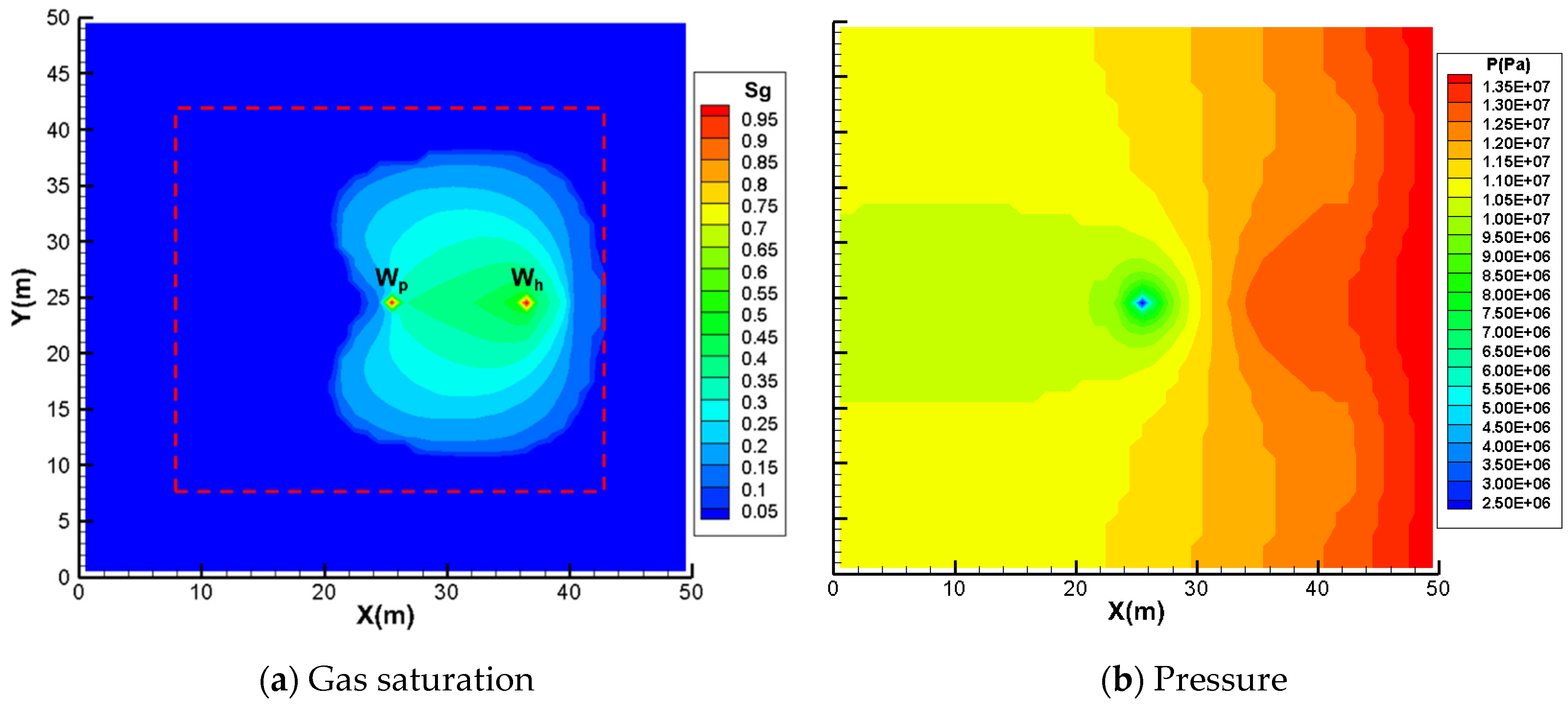
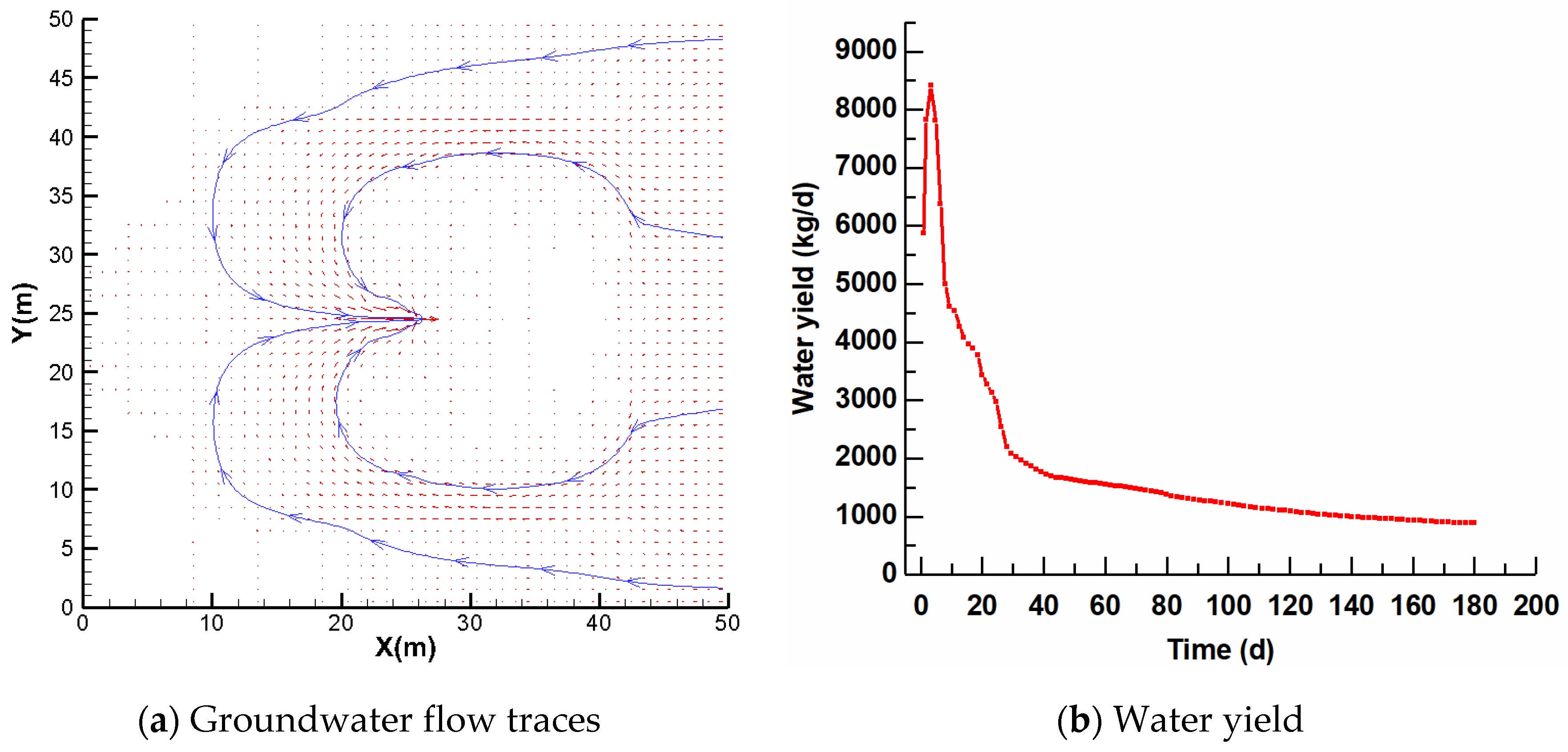
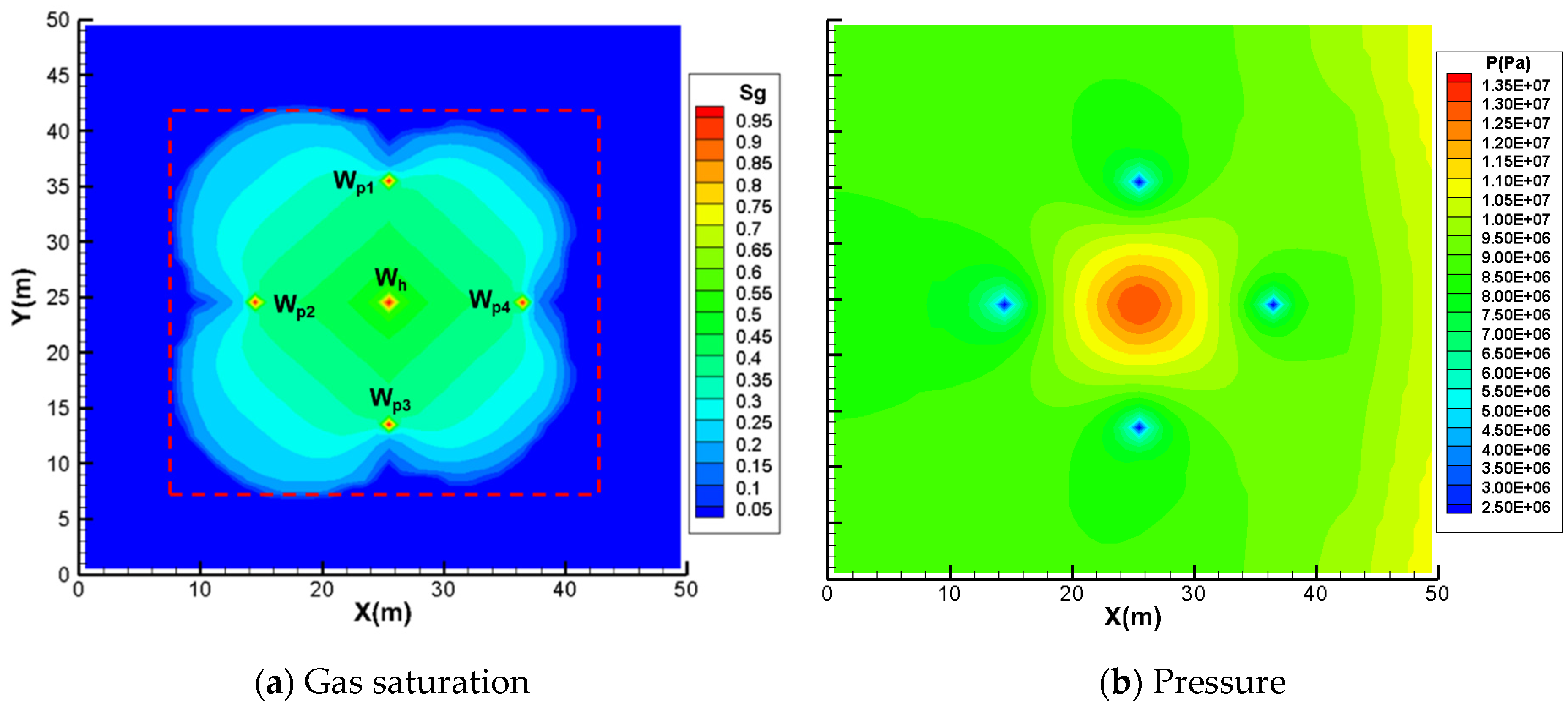
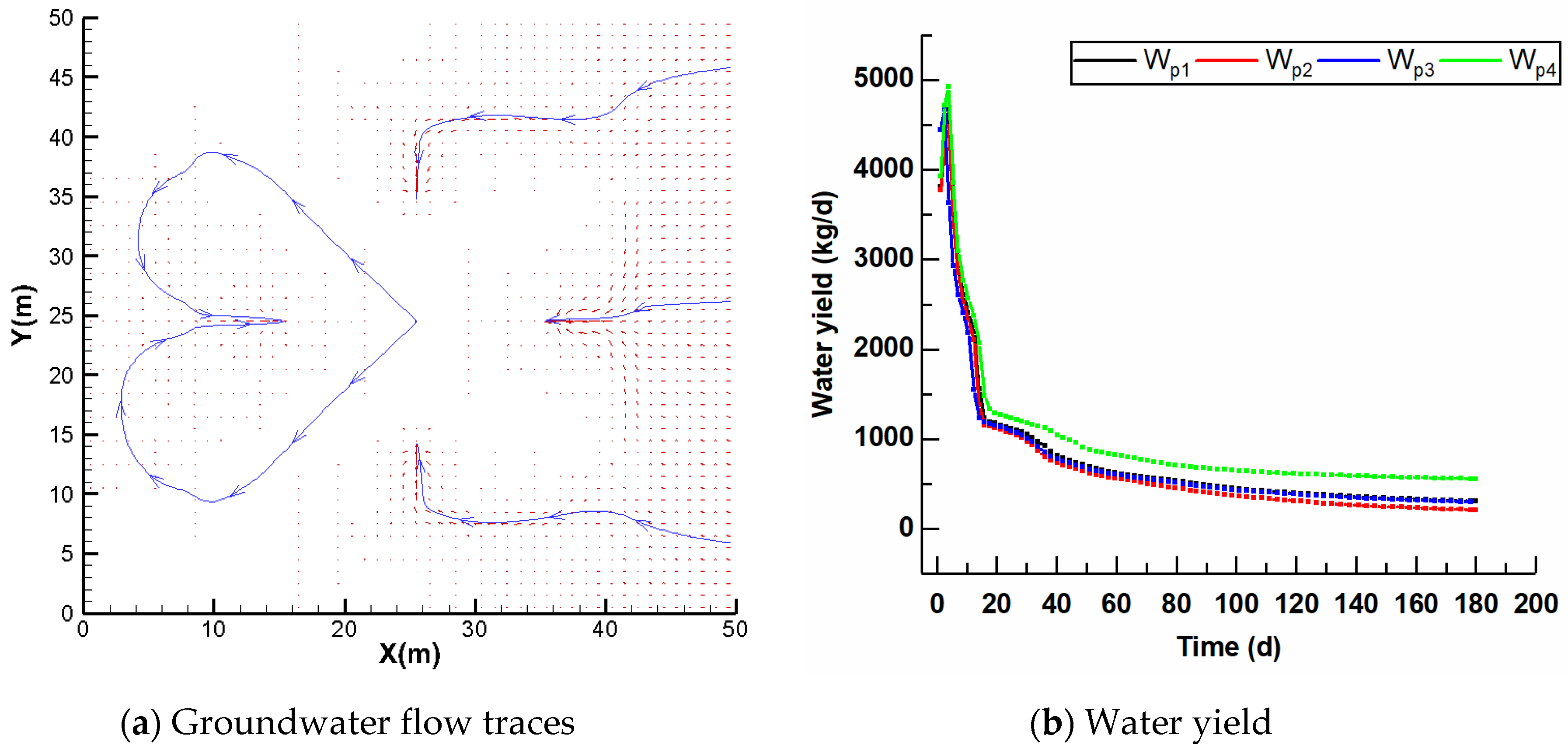
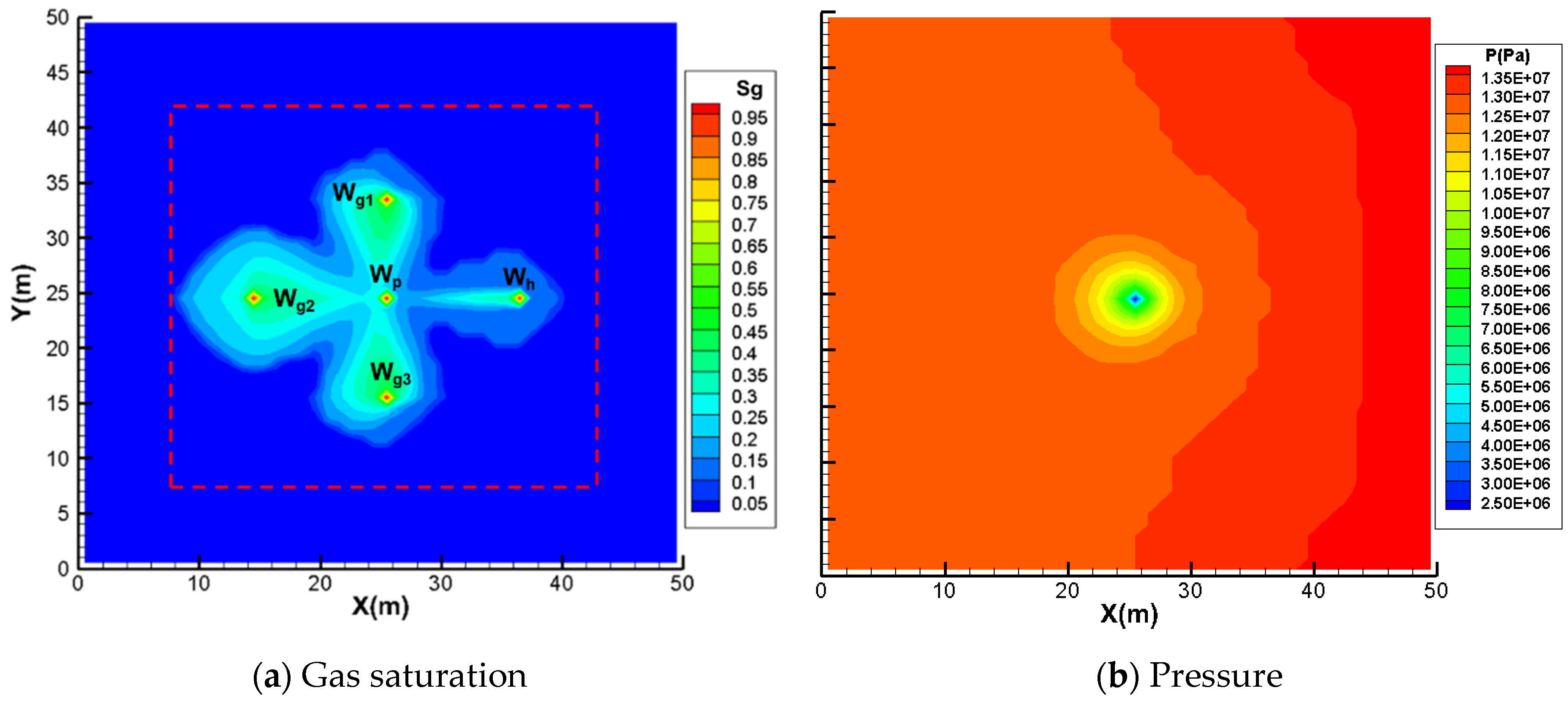
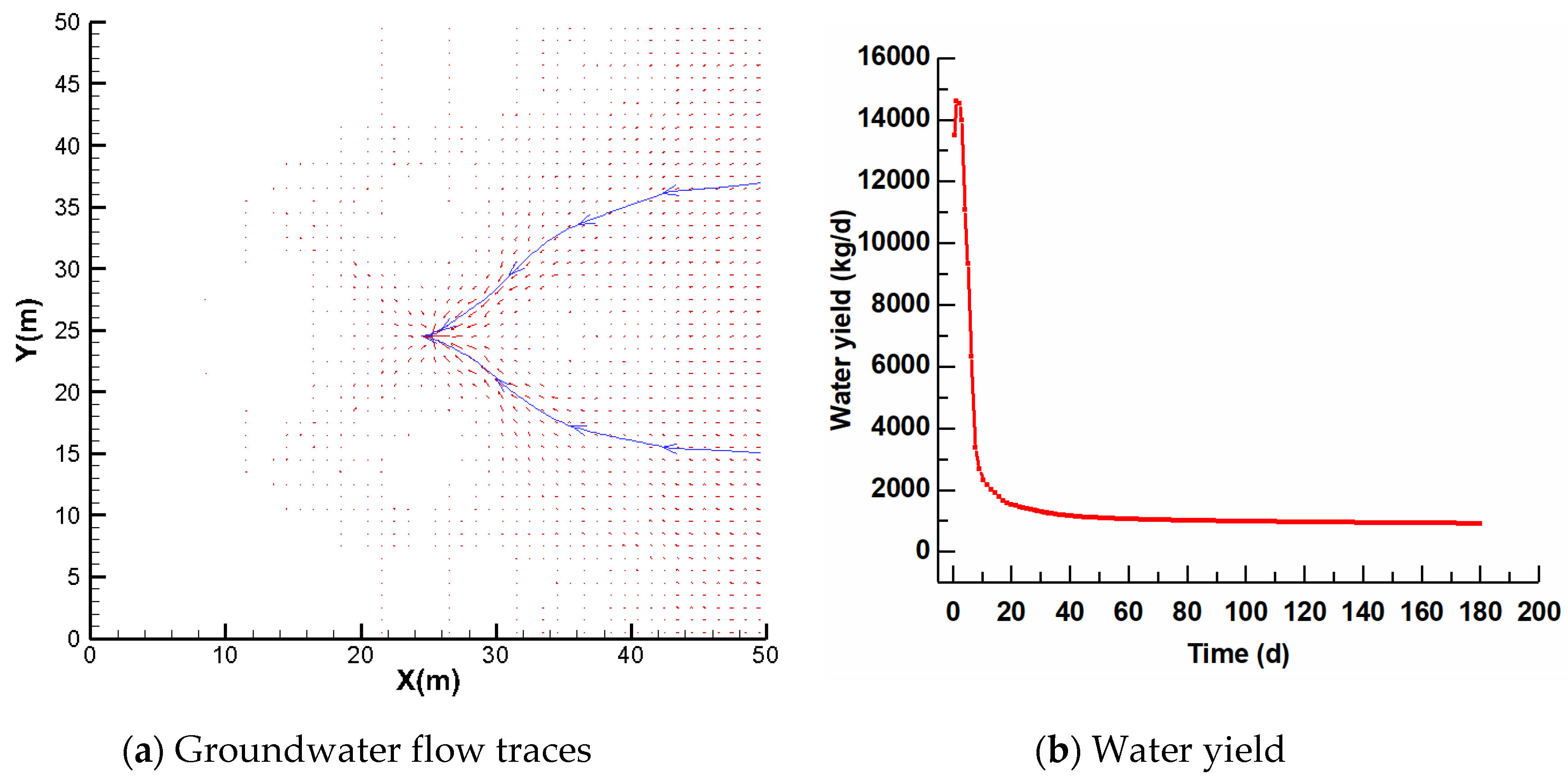

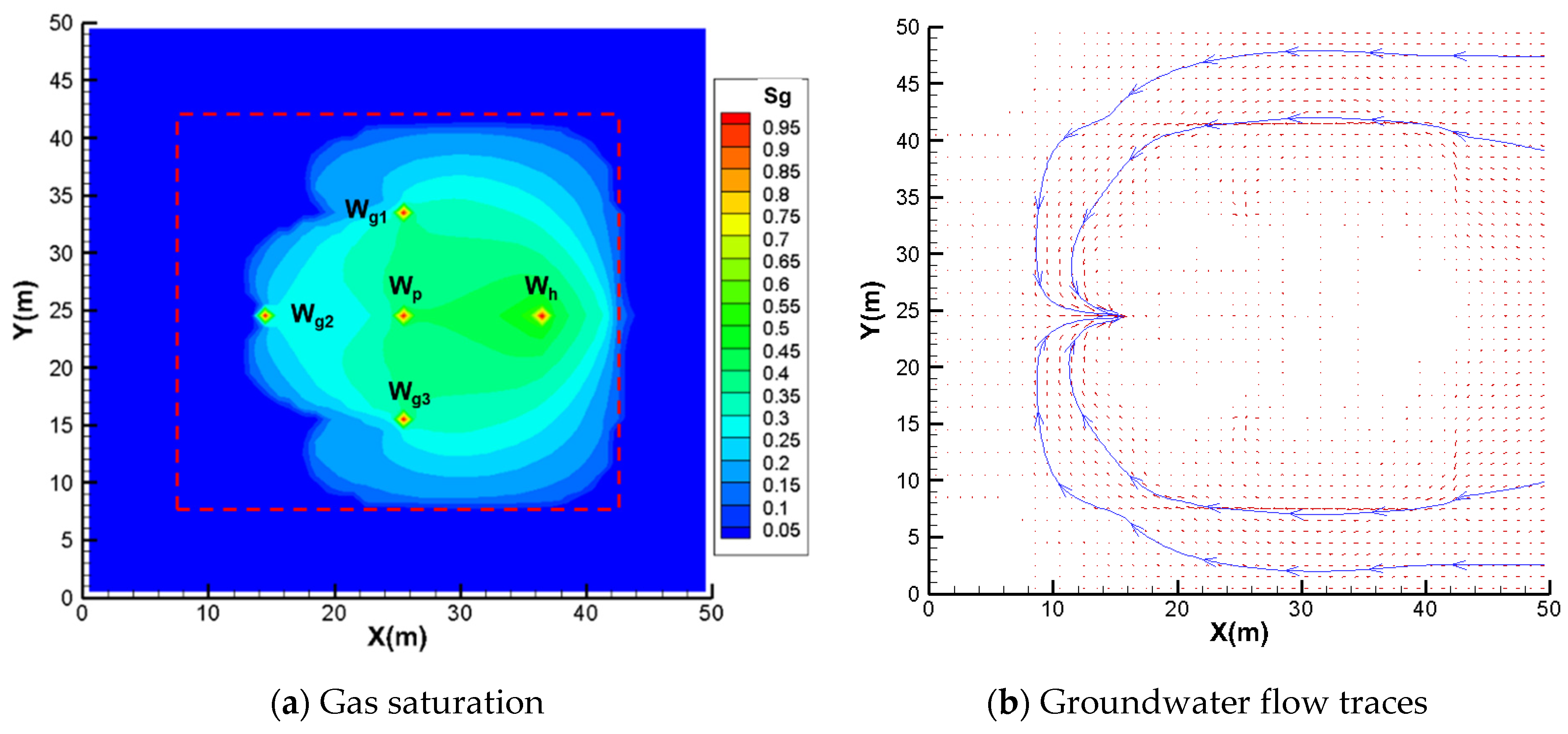
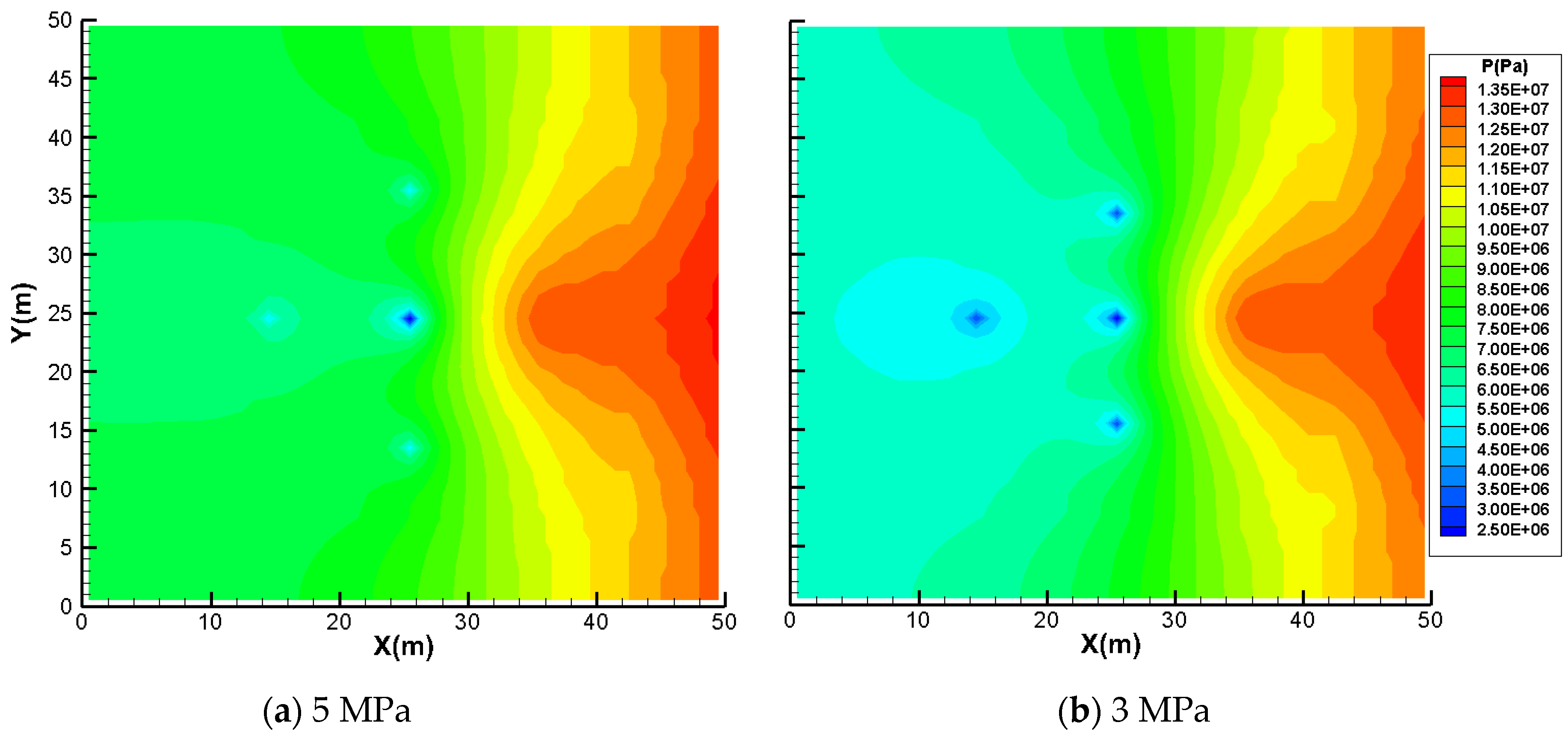

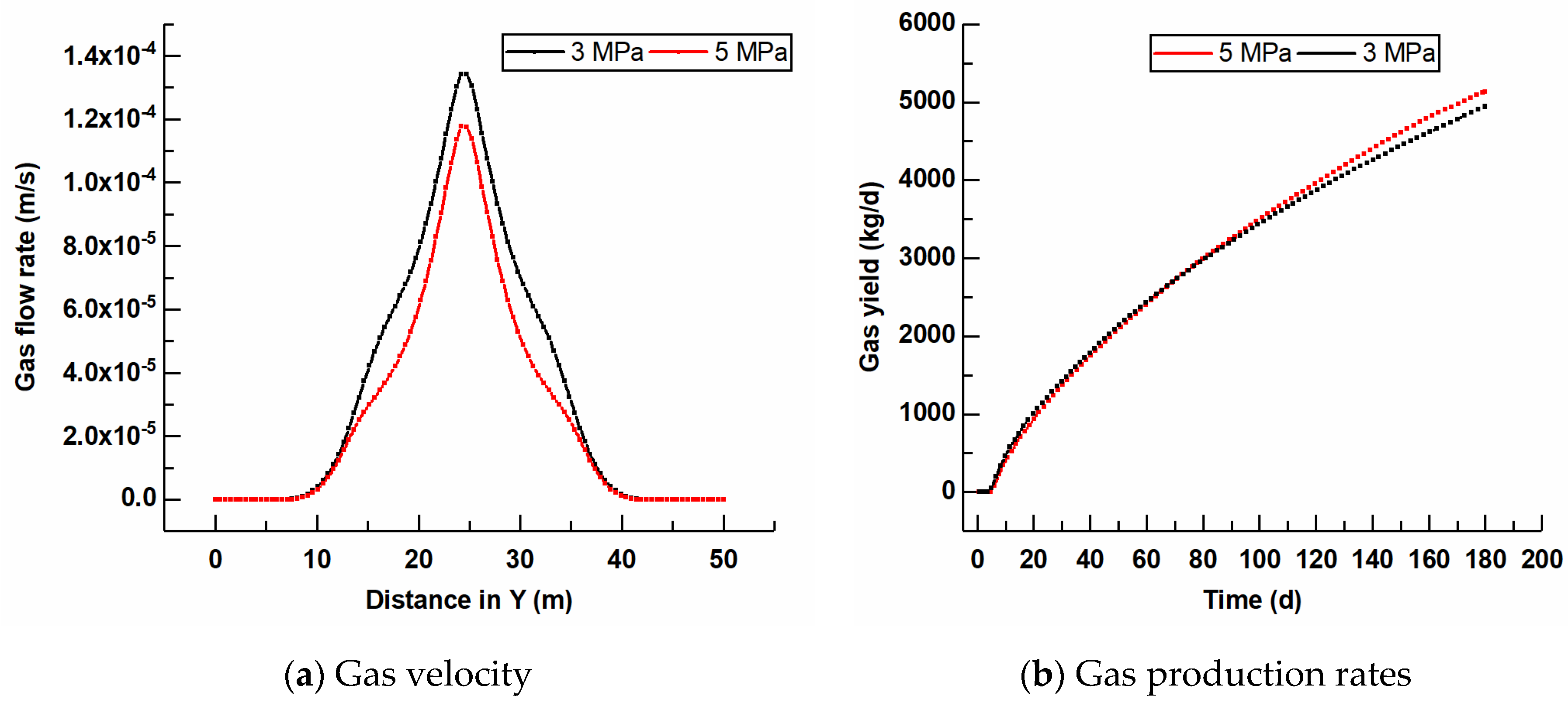
| Hydrogeological Parameters | Value |
|---|---|
| Permeability of hydraulic fracturing zone, k (m2) | 1 × 10−15 |
| Permeability of original rock, k (m2) | 1 × 10−16 |
| Porosity of hydraulic fracturing zone, φ | 0.15 |
| Porosity of original rock, φ | 0.08 |
| Density, ρ (kg/m3) | 1800 |
| Residual water saturation, Slr | 0.3 |
| Initial groundwater velocity, v (kg/s·m2) | 2.0 × 10−5 |
| van Genuchten λ | 0.457 |
| van Genuchten m (Pa−1) | 1.25 × 10−6 |
Publisher’s Note: MDPI stays neutral with regard to jurisdictional claims in published maps and institutional affiliations. |
© 2021 by the authors. Licensee MDPI, Basel, Switzerland. This article is an open access article distributed under the terms and conditions of the Creative Commons Attribution (CC BY) license (https://creativecommons.org/licenses/by/4.0/).
Share and Cite
Yang, L.; Liu, Z.; Zeng, H.; Su, J.; Wang, Y.; Chen, X.; Guo, W. Influence of Gas Flooding Pressure on Groundwater Flow during Oil Shale In Situ Exploitation. Energies 2021, 14, 8363. https://doi.org/10.3390/en14248363
Yang L, Liu Z, Zeng H, Su J, Wang Y, Chen X, Guo W. Influence of Gas Flooding Pressure on Groundwater Flow during Oil Shale In Situ Exploitation. Energies. 2021; 14(24):8363. https://doi.org/10.3390/en14248363
Chicago/Turabian StyleYang, Lihong, Zhao Liu, Hao Zeng, Jianzheng Su, Yiwei Wang, Xudong Chen, and Wei Guo. 2021. "Influence of Gas Flooding Pressure on Groundwater Flow during Oil Shale In Situ Exploitation" Energies 14, no. 24: 8363. https://doi.org/10.3390/en14248363





